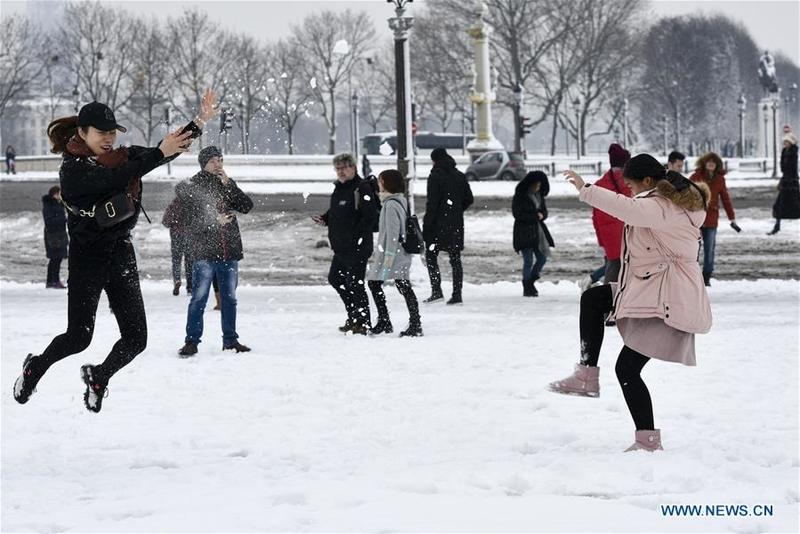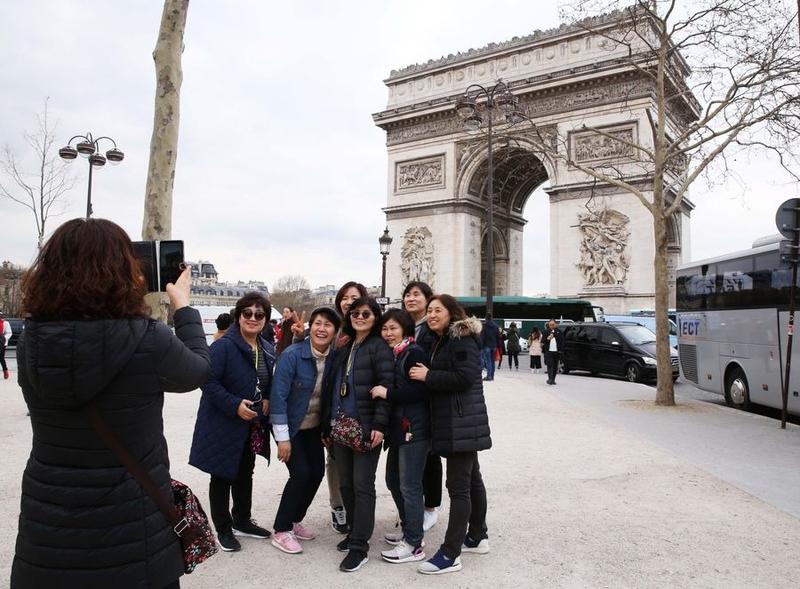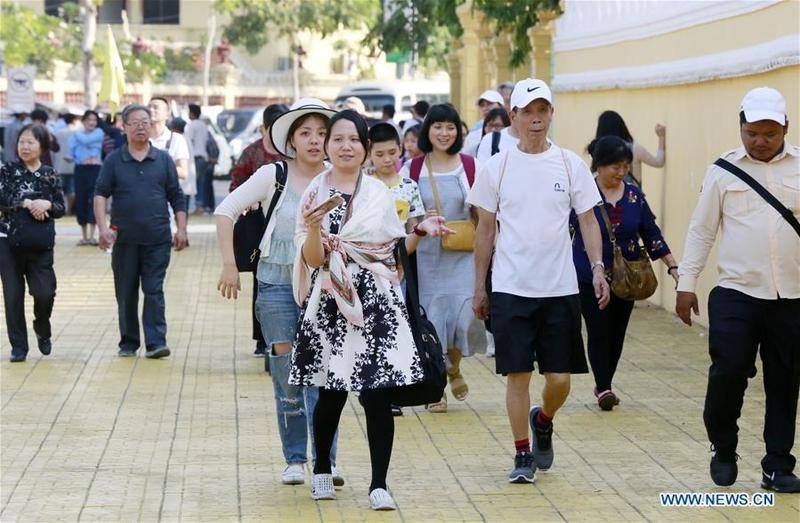 In this Feb 7, 2018 photo, Chinese tourists have a snowball fight on the Concorde Square in Paris, France. (CHEN YICHEN / XINHUA)
In this Feb 7, 2018 photo, Chinese tourists have a snowball fight on the Concorde Square in Paris, France. (CHEN YICHEN / XINHUA)
Chinese tourists’ appetite for traveling overseas will prevail despite the ongoing pandemic, which, according to experts and industry players, will be a positive signal for the recovery of global tourism.
The number of job losses in the travel and tourism sector could exceed 197m in 2020 due to the pandemic, according to estimates by the World Travel and Tourism Council in June
“Just like nobody would have ever imagined China to be the world’s largest outbound tourism market, one cannot make the judgment now that Chinese tourists will lose their interest in travelling abroad,” said Wendy Min, director of international affairs at Trip.com Group, a leading online travel agency in China.
The number of outbound Chinese travelers has maintained at the top spot globally ever since 2013, according to a report by the National Bureau of Statistics in August 2019.
Min said she is optimistic about the recovery of Chinese outbound tourism after the pandemic. “People will go overseas if their safety and health can be ensured,” she said, noting the demand for travel remains high among Chinese travelers.
ALSO READ: Cultural tourism mushrooms in small villages
Case in point is a live-streamed program on July 1 hosted by Trip.com and the Korea Tourism Organization. Aiming to promote and sell tourism products in South Korea, the show attracted over 2 million viewers. A number of hotel vouchers were sold out on the same day, according to local media Yonhap News Agency.
Similarly, a report by Rentals United – a short-term rental platform based in the United Kingdom – also predicted that Chinese travelers are likely to be the first to restart traveling after lockdown restrictions are lifted within the nation and worldwide.
Market recovery has already been seen in the domestic tourism market. During the four-day Labor Day holiday in May, attractions nationwide received over 100 million travelers. Meanwhile, around 78.79 million passenger trips were made during the just-completed Dragon Boat Festival holiday that ended on June 27, according to official data.
“A similar rebound might take place in the outbound tourism sector, because many travel lovers have been waiting for a long time to go overseas,” said Min. “The industry may see ‘revenge travel’ after the pandemic, when there is a vaccine and when international flights are resumed.”
Echoing Min’s view, Wolfgang Georg Arlt, CEO of China Outbound Tourism Research Institute (COTRI), said the reasons behind Chinese desire to see the world and the corresponding urge to do so have not changed because of the pandemic.
“China is the biggest (tourist) source market, so the faster Chinese visitors can travel again internationally, the better for the global tourism industry,” said Arlt.
As many countries have imposed travel restrictions for foreign travelers to prevent and control the spread of the novel coronavirus – which has already infected more than 12 million people globally – the pandemic continues to stifle tourism worldwide.
 In this March 20, 2019 photo, group of Chinese tourists pose for a photo at the Arc de Triomphe in Paris, France. (GAO JING / XINHUA)
In this March 20, 2019 photo, group of Chinese tourists pose for a photo at the Arc de Triomphe in Paris, France. (GAO JING / XINHUA)
The number of job losses in the travel and tourism sector could exceed 197 million in 2020 due to the pandemic, according to estimates by the World Travel and Tourism Council in June. Meanwhile, the industry could incur a loss of up to US$5.5 trillion.
In Asia, China is among, if not the largest, tourist source country of many popular regional destinations including Thailand, Japan, Vietnam and Indonesia.
Cindy Yao, managing director of Indonesian travel agency Travindo Multi Express, said she has lost over 95 percent of her clients from China since the beginning of the COVID-19 outbreak. The company mainly provides services to Chinese business traveler groups that visit Indonesia for exhibitions, fairs and meetings as well as leisure.
“Everything related to tourism, from airlines, hospitality to tour guides and duty-free shops, have been heavily hit,” said Yao. “The flights between Indonesia and China have been almost completely suspended, bringing our travel and exhibition-related businesses to a full stop.”
The Jakarta Post reported in March, citing Indonesia Hotel and Restaurant Association Chairman Hariyadi B Sukamdani, that the country’s tourism sector lost at least US$1.5 billion since January, with a loss of about US$1.1 billion resulting from cancelations by Chinese tourists alone.
Yao had to switch the company’s focus to domestic tourism in the hope of surviving. Yet she believes that Chinese tourists will return to drive market recovery once the pandemic is over.
“The Chinese outbound tourism market has gone through ups and downs over the years, and it is now a very resilient one,” said Yao. “Even though the tourism sector, as a whole, has been hit hard by the COVID-19 outbreak, in the long run, it will rebound fast along with Chinese tourists’ strong demand for overseas travel.”
Many countries in the region have expressed their willingness to attract Chinese tourists after the pandemic.
After resuming international flights since July 1, Thailand has reopened its gates to medical and wellness tourists, according to a government announcement. The tourism and sports ministry is also working on launching a travel bubble scheme to allow leisure travelers from low-risk regions including China to visit popular destinations. It also said in early July that it will launch a campaign targeting specific provinces in China to attract visitors, as reported by the Bangkok Post.
Back in May, Cambodian Tourism Minister Thong Khon said explicitly that the country hopes Chinese tourists will drive its tourism growth when the pandemic is over, as reported by Xinhua News Agency. Top Sopheak, secretary of state and spokesman of the Tourism Ministry, also said the country will continue to promote the “China Ready” strategy and prepare to receive tourists from China in the post-COVID-19 era.
But the recovery of international travel has to take baby steps, said Trip.com’s Min, noting countries can only open their borders and reconnect through joint efforts due to the COVID-19 situation.
 In this Jan 29, 2019 photo, Chinese tourists walk beside the Royal Palace in Phnom Penh, Cambodia. (PHEARUM / XINHUA)
In this Jan 29, 2019 photo, Chinese tourists walk beside the Royal Palace in Phnom Penh, Cambodia. (PHEARUM / XINHUA)
For example, the travel bubble scheme, which is now mainly limited to essential business trips, can be gradually expanded to accommodate leisure tourists when cross-border travel becomes safer.
China and South Korea launched a “fast-track” entry program for essential personnel on urgent visits on May 1. Since then, nearly 3,700 people from South Korea have utilized the channel to enter China, South Korea’s Ambassador to China Jang Ha-sung said on June 29, as quoted by Yonhap.
As China eased restrictions on international flights in early June, South Korean airlines are also reportedly planning to add more regular routes to China. On July 7, Asiana Airlines announced on Chinese microblogging platform Weibo that it will resume the route between Incheon and Nanjing of East China’s Jiangsu province – the first resumption of a flight route between the two countries.
South Korea’s transport ministry said on July 12 that the country is in talks with China to increase the number of flights to China to from three to ten a week, according to Yonhap.
“During the severe acute respiratory syndrome, or SARS, outbreak, many Chinese people also chose not to travel, but the industry soon rebounded when the outbreak was under control,” said Min. “As long as the safety of the trip can be ensured, people will still travel.”
COTRI’s Arlt said that after the pandemic, the way Chinese tourists travel might change.
Some people may look for more meaningful journeys as opposed to vanity trips while some will travel more with their family, seek out natural destinations and activities, or slow down and become more interested in local culture, Arlt said.
“Life is precious and fragile, we all have learned that in the past months,” Arlt said.
 In this udated photo, Chinese tourists pose for pictures with a joint patrol team composed of police officers from Italy and China. (PHOTO / XINHUA)
In this udated photo, Chinese tourists pose for pictures with a joint patrol team composed of police officers from Italy and China. (PHOTO / XINHUA)
Noting tourist attractions need to take new measures to convince travelers of their safety, Min said that what destinations can do for now is maintain communication and exchanges in order to keep themselves in the minds of Chinese tourists. Those which can guarantee safety will be more attractive to Chinese travelers in the post-pandemic era.
Travindo’s Yao said her company has been keeping in touch with its Chinese counterparts, hoping to seize the opportunity once the market starts to rebound.
READ MORE: UNCTAD: Global tourism losses may exceed US$1.2 trillion
“It’s too soon to talk about any specific plans targeting Chinese tourists after the pandemic, but we hope to find ways to improve our services and recruit more Chinese-speaking employees to meet the market demand,” she said. “I hope, during the Chinese Spring Festival holiday in 2021, we can see the revival of international tourism.”
Thinking the travel bubble will no longer be necessary after some months, Arlt expects to see a “wave” of Chinese outbound tourism in the last quarter of 2020. Chinese travelers, he said, will be essential not just for Asian destinations but for other countries like Germany in Europe. “Many surveys showed that trips have not been cancelled, but just postponed.”


